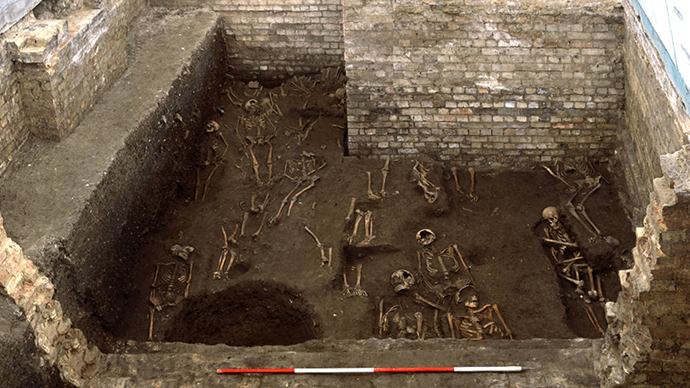Medieval tomb: 1,300 bodies discovered under Cambridge college

One of the largest medieval hospital cemeteries ever discovered in Britain, filled with the remains of more than 1,000 people, has been discovered beneath a Cambridge University college.
The burial ground, which has lain hidden for centuries, once stood on the site of what is now St John’s College in Cambridge.
It was unearthed during refurbishment work three years ago. While the existence of the cemetery has been known to historians since the mid-20th century, it has only now been made public.
The cemetery dates back to around the 13th century.
During a six-month dig, a team of 20 archaeologists tunneled their way through the college floors, unearthing the remains of 1,300 people, including 400 complete skeletons.
They are thought to be patients of a medieval hospital that stood opposite the graveyard until 1511.
Many of those laid to rest were “sick or homeless” Cambridge University scholars, who were “too poor to take care of themselves.”
The cemetery appeared to “serve the poor,” as the dead were buried without coffins, some even without shrouds.
Very few of the bodies belonged to women and children, as the site’s “main purpose was to cater for poor scholars and other wretched persons.”
Experts say an on-going DNA analysis of the remains will help cast light on life and death in medieval Britain.

According to the Archaeological Journal, the project’s findings suggest the medieval hospital’s main role was for spiritual “and physical care of the poor and infirm rather than medical treatment of the sick and injured.”
Next to the “neatly arranged” skeletons lay the personal items of the deceased, such as jewelry, which may “represent grave-goods.”
According to Dr Craig Cessford of Cambridge University’s department of archaeology and anthropology, the: “Items were found in graves that might represent grave-goods, but their positions were ambiguous.”
“It is equally possible that they represent residual material from earlier activity at the site.”
He told the Mail Online the burial site is “a quite amazing find,” as many knew there was a cemetery in the area but “we didn’t know for definite it was where we were working.”
READ MORE: London gardener unearths unexploded
bomb (VIDEO)
Most of the skeletons discovered belonged to 25 to 45-year-old men, Cessford says.
“The skeletons were buried in neat rows and once it was full, more were buried on top,” he added.
Cessford told RT "it was quite a shocking and amazing feeling" to see the skeletons all revealed.
Locals have rumored the hospital cemetery could have been linked to the Black Death, but no evidence of the disease was found in any of the remains. Nor did the team discover any sign of large burial groups from that period.
A spokesperson from Cambridge University told RT the remains “are currently being stored with the Cambridge Archaeological Unit for further research.”
Gravel paths were discovered in the cemetery, suggesting people visited their deceased loved ones, yet the names of the dead still remain a mystery.












